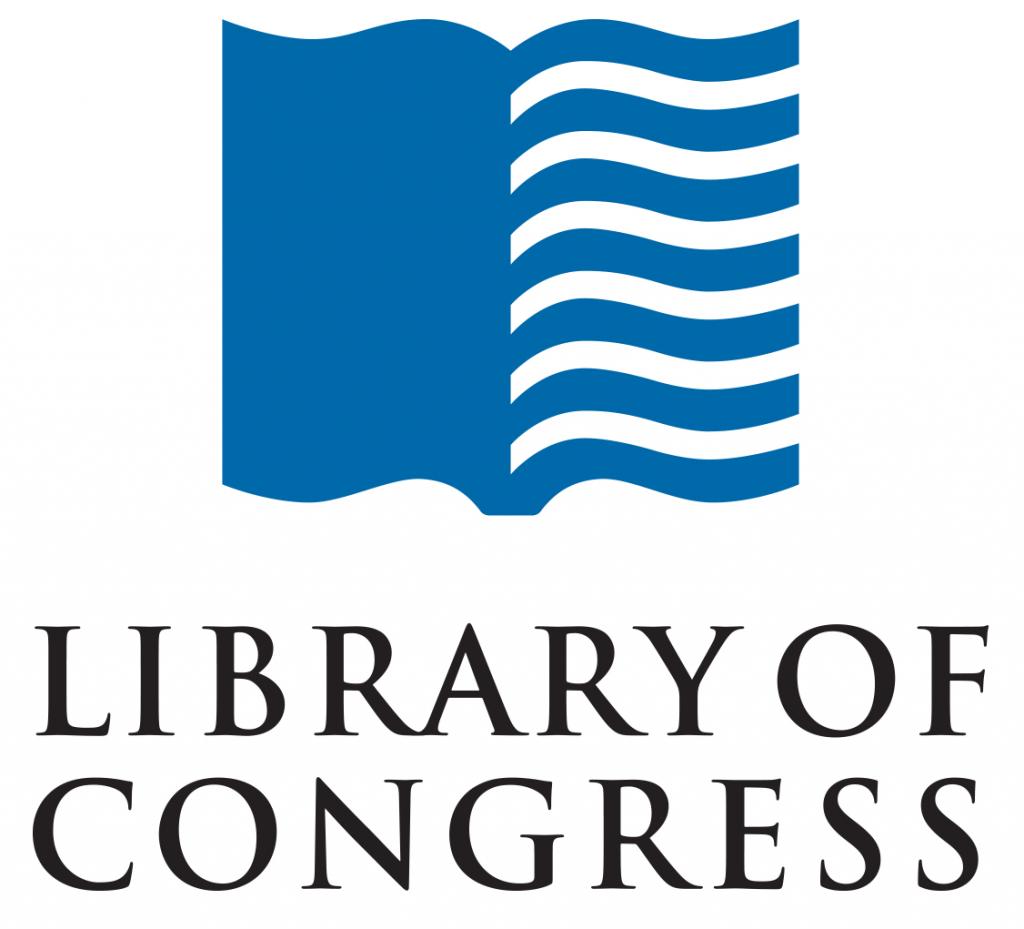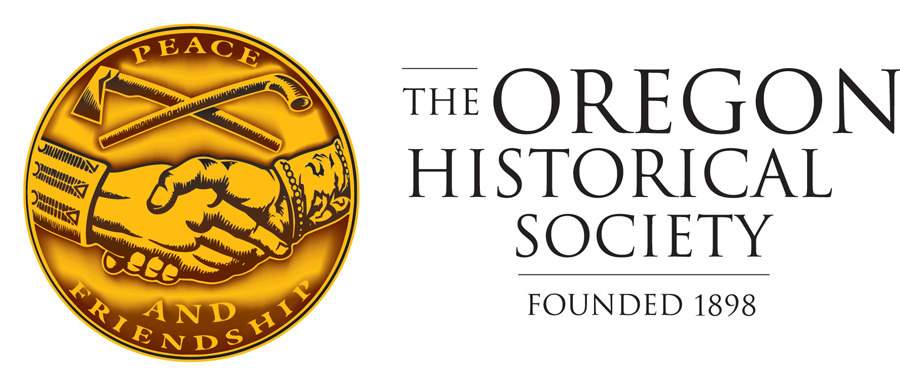from May. 1, 1865
Abraham Lincoln's funeral march
-
Full Title
Abraham Lincoln's funeral march
-
Description
Slow march based on Abraham Lincoln's funeral, associated with the Union side. Composed for solo piano. Part of the Library of Congress Civil War Sheet Music Collection.
-
Source
-
Rights
Public Domain. Suggested credit line: Civil War Sheet Music Collection, Library of Congress, Music Division.
-
Tags
-
Cite this Item
Bach, C. H. . "Abraham Lincoln's funeral march". Milwaukee, WI: H. N. Hempsted, 1865. Remembering Lincoln. Web. Accessed May 15, 2025. https://rememberinglincoln.fords.org/node/1022
from May. 1, 1865
Abraham Lincoln's funeral march

-
Description
Slow march based on Abraham Lincoln's funeral, associated with the Union side. Composed for solo piano. Part of the Library of Congress Civil War Sheet Music Collection.
-
Source
-
Rights
Public Domain. Suggested credit line: Civil War Sheet Music Collection, Library of Congress, Music Division.
-
Creator
Bach, C. H.
-
Publisher
Milwaukee, WI: H. N. Hempsted, 1865
-
Date
May 1, 1865
-
Material
Sheet Music
from
Philadelphia Funeral Procession Details
-
Full Title
Philadelphia Funeral Procession Details
-
Description
This document describes the arrangement of the funeral procession that accompanied Abraham Lincoln's body while in Philadelphia. The text describes the street routes of the procession, the logistics of moving from Independence Hall for the viewing to Christ Church for the religious funeral services, and the order, formation, and conduct of the procession.
-
Source
The Abraham Lincoln Foundation of The Union League of Philadelphia (Object ID: XI.2.1963.3.1)
-
Rights
Use of this item for research, teaching and private study is permitted with proper citation and attribution, as “Courtesy of The Abraham Lincoln Foundation of The Union League of Philadelphia.” Reproduction of this item for publication, broadcast or commercial use requires written permission. For permission, please contact The Abraham Lincoln Foundation.
-
Tags
-
Cite this Item
Unknown. "Philadelphia Funeral Procession Details". Remembering Lincoln. Web. Accessed May 15, 2025. https://rememberinglincoln.fords.org/node/1010
from
Philadelphia Funeral Procession Details
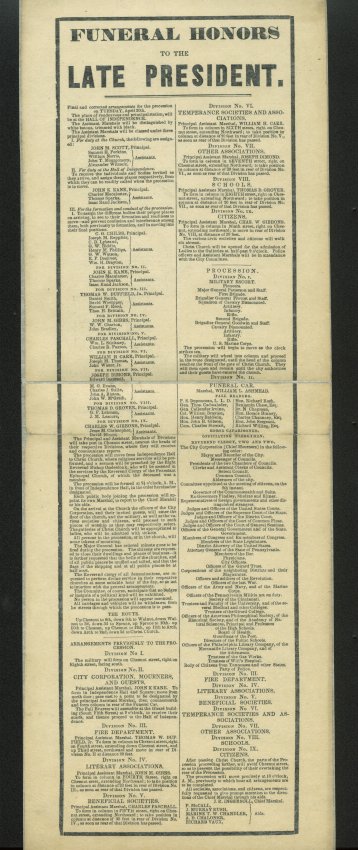
-
Description
This document describes the arrangement of the funeral procession that accompanied Abraham Lincoln's body while in Philadelphia. The text describes the street routes of the procession, the logistics of moving from Independence Hall for the viewing to Christ Church for the religious funeral services, and the order, formation, and conduct of the procession.
-
Source
The Abraham Lincoln Foundation of The Union League of Philadelphia (Object ID: XI.2.1963.3.1)
-
Rights
Use of this item for research, teaching and private study is permitted with proper citation and attribution, as “Courtesy of The Abraham Lincoln Foundation of The Union League of Philadelphia.” Reproduction of this item for publication, broadcast or commercial use requires written permission. For permission, please contact The Abraham Lincoln Foundation.
-
Creator
Unknown
-
Material
Ink and paper
from Apr. 22, 1865
Union League Funeral Ticket
-
Full Title
Union League of Philadelphia Funeral Invitation Ticket
-
Description
President Lincoln's funeral procession traveled from Washington, D.C., to Springfield, Illinois. When the procession stopped in Philadelphia, members of the Union League received the President's body at Independence Hall before the public viewing on April 23.
-
Source
The Abraham Lincoln Foundation of The Union League of Philadelphia (Object ID: XI.2.004)
-
Rights
Use of this item for research, teaching and private study is permitted with proper citation and attribution, as “Courtesy of The Abraham Lincoln Foundation of The Union League of Philadelphia.” Reproduction of this item for publication, broadcast or commercial use requires written permission. For permission, please contact The Abraham Lincoln Foundation.
-
Tags
-
Cite this Item
Union League of Philadelphia. "Union League of Philadelphia Funeral Invitation Ticket". Remembering Lincoln. Web. Accessed May 15, 2025. https://rememberinglincoln.fords.org/node/1007
from Apr. 22, 1865
Union League of Philadelphia Funeral Invitation Ticket
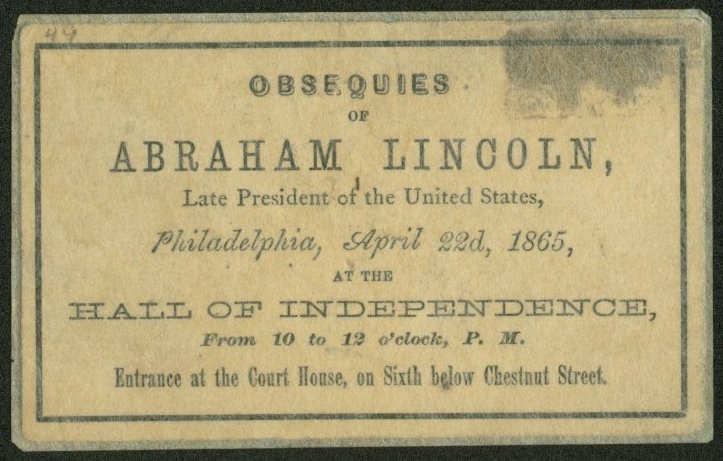
-
Description
President Lincoln's funeral procession traveled from Washington, D.C., to Springfield, Illinois. When the procession stopped in Philadelphia, members of the Union League received the President's body at Independence Hall before the public viewing on April 23.
-
Source
The Abraham Lincoln Foundation of The Union League of Philadelphia (Object ID: XI.2.004)
-
Rights
Use of this item for research, teaching and private study is permitted with proper citation and attribution, as “Courtesy of The Abraham Lincoln Foundation of The Union League of Philadelphia.” Reproduction of this item for publication, broadcast or commercial use requires written permission. For permission, please contact The Abraham Lincoln Foundation.
-
Creator
Union League of Philadelphia
-
Date
April 22, 1865
-
Material
Ink and Paper
from Apr. 21, 1865
Union League Funeral Invitation
-
Full Title
Union League of Philadelphia Funeral Invitation Letter
-
Description
Secretary of The Union League of Philadelphia, George H. Boker, wrote to League members about their role in receiving President Lincoln's body during the funeral procession through Philadelphia.
-
Transcription
UNION LEAGUE HOUSE,
Philadelphia, April 21, 1865.
SIR:
The Committee of the Select and the Common Councils of Philadelphia, having conferred upon the “UNION LEAGUE” the honor of receiving the body of the late President of the United States on its arrival in Independence Square, you are requested to meet your fellow-members at Concert Hall, at an hour to be hereafter announced, for the purpose of assisting at that ceremony.
It is the earnest desire of the Board that every member of the League, wearing his badge, shall be present on this occasion.
George H. Boker,
Secretary.
[Transcription by: Ricarda H., Dr. Susan Corbesero’s Class, Ellis School, Pittsburgh, Pennsylvania] -
Source
The Abraham Lincoln Foundation of The Union League of Philadelphia (Object ID: XI.2.003)
-
Rights
Use of this item for research, teaching and private study is permitted with proper citation and attribution, as “Courtesy of The Abraham Lincoln Foundation of The Union League of Philadelphia.” Reproduction of this item for publication, broadcast or commercial use requires written permission. For permission, please contact The Abraham Lincoln Foundation.
-
Tags
-
Cite this Item
George H. Boker. "Union League of Philadelphia Funeral Invitation Letter". Union League of Philadelphia. Remembering Lincoln. Web. Accessed May 15, 2025. https://rememberinglincoln.fords.org/node/1006
from Apr. 21, 1865
Union League of Philadelphia Funeral Invitation Letter
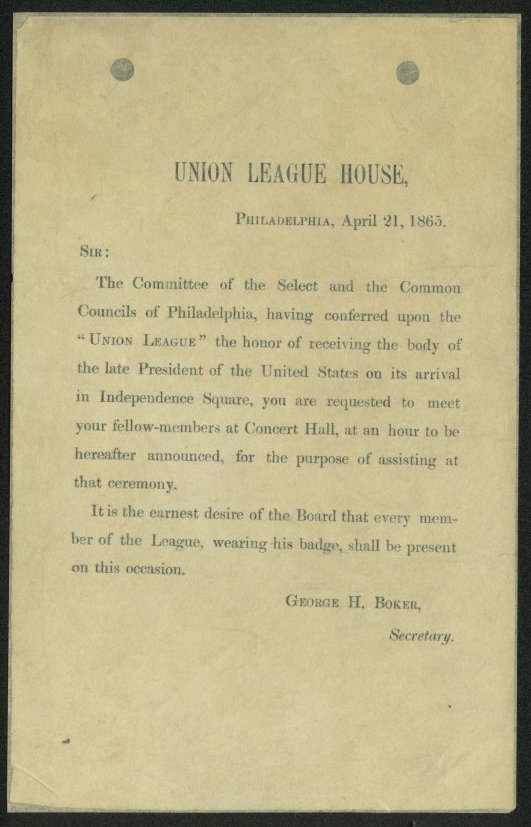
-
Description
Secretary of The Union League of Philadelphia, George H. Boker, wrote to League members about their role in receiving President Lincoln's body during the funeral procession through Philadelphia.
-
Source
The Abraham Lincoln Foundation of The Union League of Philadelphia (Object ID: XI.2.003)
-
Rights
Use of this item for research, teaching and private study is permitted with proper citation and attribution, as “Courtesy of The Abraham Lincoln Foundation of The Union League of Philadelphia.” Reproduction of this item for publication, broadcast or commercial use requires written permission. For permission, please contact The Abraham Lincoln Foundation.
-
Creator
George H. Boker
-
Publisher
Union League of Philadelphia
-
Date
April 21, 1865
-
Material
ink on paper
from Apr. 15, 1865
George Himes Diary
-
Full Title
George Himes Diary
-
Description
In 1865, George Henry Himes was a typesetter for the Oregonian newspaper in Portland, Oregon, when he heard of Lincoln's assassination, presumably via telegraph. Himes then worked to publish a special edition of the Oregonian, which, as he noted in his diary, brought an extra $79 (equal to $1,221.24 in 2015) in sales. Himes also reported that stores closed in mourning. On Wednesday, April 19, Himes noted that stores were again closed in honor of Lincoln's funeral, taking place at that moment across the continent in Washington, D.C. Himes later owned a printing company and was among the founders of the Oregon Historical Society.
-
Source
George Himes papers, Mss 1462, Oregon Historical Society, Davies Family Research Library
-
Rights
Use of this item for research, teaching, and private study is permitted with proper citation and attribution. Reproduction of this item for publication, broadcast, or commercial use requires written permission.
-
Tags
-
Cite this Item
George Himes. "George Himes Diary". Remembering Lincoln. Web. Accessed May 15, 2025. https://rememberinglincoln.fords.org/node/1005
from Apr. 15, 1865
George Himes Diary
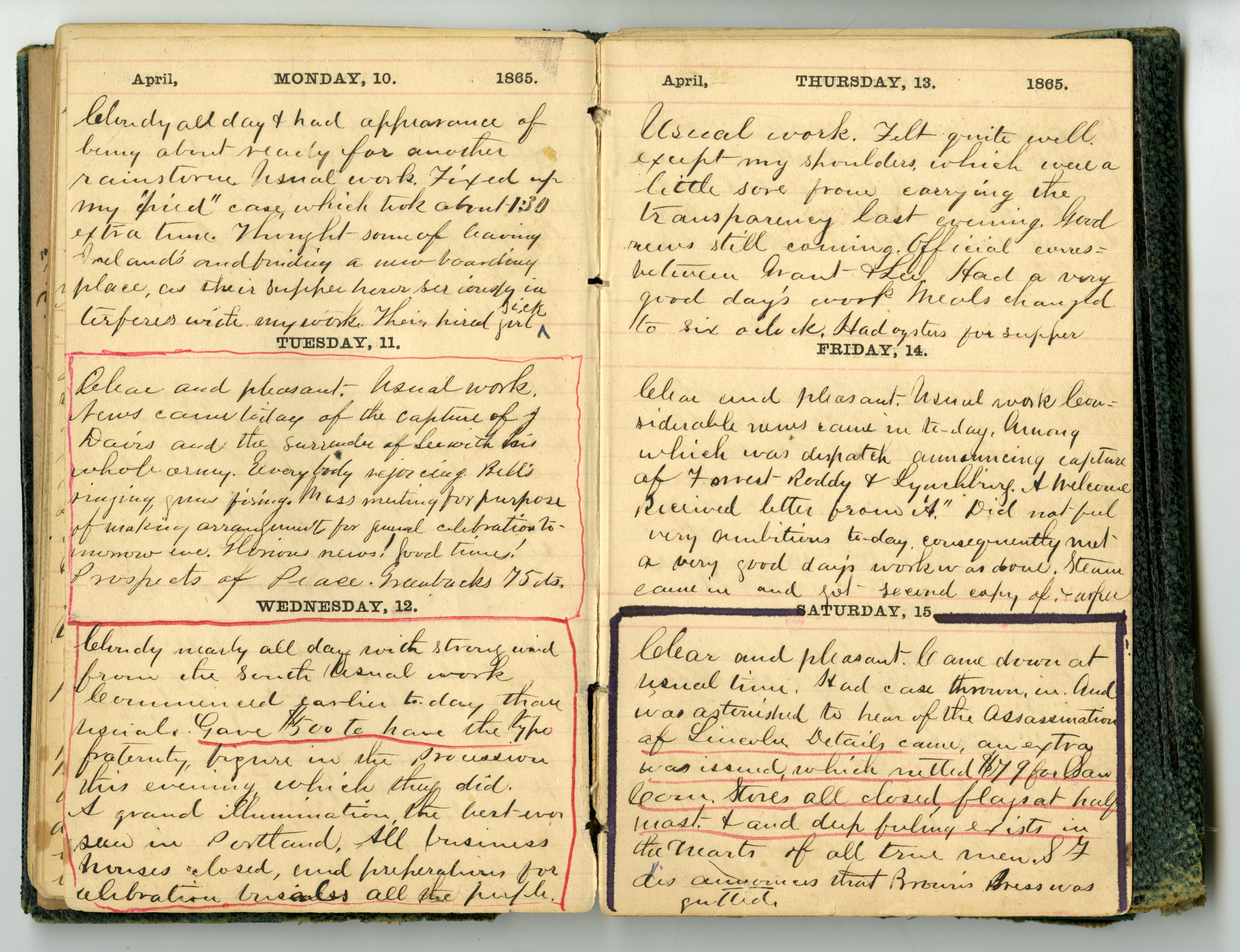
-
Description
In 1865, George Henry Himes was a typesetter for the Oregonian newspaper in Portland, Oregon, when he heard of Lincoln's assassination, presumably via telegraph. Himes then worked to publish a special edition of the Oregonian, which, as he noted in his diary, brought an extra $79 (equal to $1,221.24 in 2015) in sales. Himes also reported that stores closed in mourning. On Wednesday, April 19, Himes noted that stores were again closed in honor of Lincoln's funeral, taking place at that moment across the continent in Washington, D.C. Himes later owned a printing company and was among the founders of the Oregon Historical Society.
-
Source
George Himes papers, Mss 1462, Oregon Historical Society, Davies Family Research Library
-
Rights
Use of this item for research, teaching, and private study is permitted with proper citation and attribution. Reproduction of this item for publication, broadcast, or commercial use requires written permission.
-
Creator
George Himes
-
Date
April 15, 1865
from Apr. 16, 1865
American Flag
-
Full Title
Maria Fassett Harvey Flag
-
Description
Irish immigrant Maria Fassett Harvey lived at 713 South 11th Street, Philadelphia, in April 1865. When she learned that Abraham Lincoln’s body was to lie in state at Independence Hall, she, like many other Philadelphians, searched for an American flag to hang out of her window. Maria could not find a flag to buy, so she purchased the necessary materials, and made her own. The flag has the appropriate 13 stripes, but features only 28 stars although there were 35 states in the Union. A bulletin from Maria's church, dated February 1901, describes Maria Harvey’s motivations and how she used the flag to mourn the loss of every president since Lincoln’s death.
-
Source
The Abraham Lincoln Foundation of The Union League of Philadelphia (Object ID: 2003.100.1)
-
Rights
Use of this item for research, teaching and private study is permitted with proper citation and attribution, as “Courtesy of The Abraham Lincoln Foundation of The Union League of Philadelphia.” Reproduction of this item for publication, broadcast or commercial use requires written permission. For permission, please contact The Abraham Lincoln Foundation.
-
Tags
-
Cite this Item
Maria Fassett Harvey. "Maria Fassett Harvey Flag". Remembering Lincoln. Web. Accessed May 15, 2025. https://rememberinglincoln.fords.org/node/1002
from Apr. 16, 1865
Maria Fassett Harvey Flag
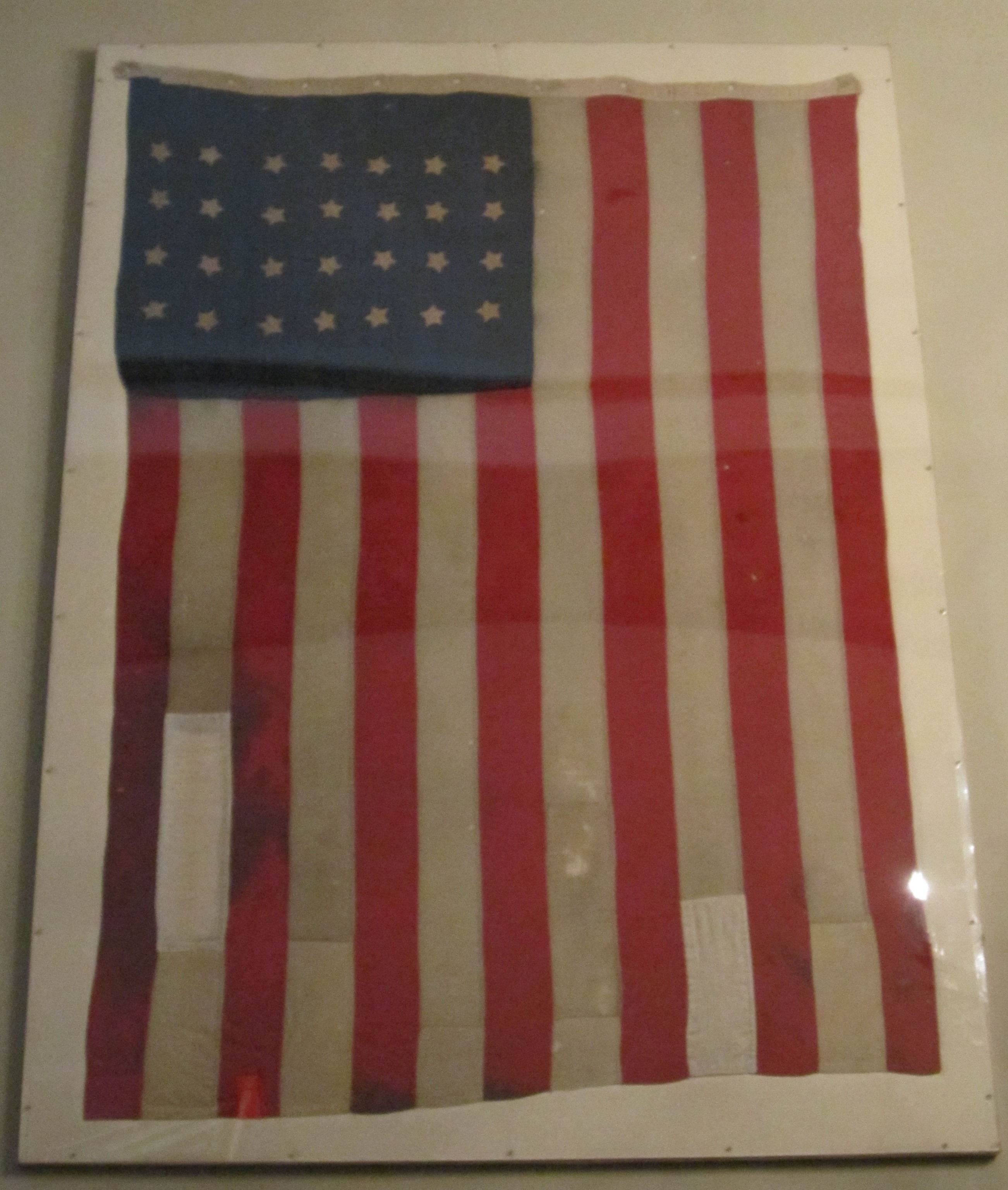
-
Description
Irish immigrant Maria Fassett Harvey lived at 713 South 11th Street, Philadelphia, in April 1865. When she learned that Abraham Lincoln’s body was to lie in state at Independence Hall, she, like many other Philadelphians, searched for an American flag to hang out of her window. Maria could not find a flag to buy, so she purchased the necessary materials, and made her own. The flag has the appropriate 13 stripes, but features only 28 stars although there were 35 states in the Union. A bulletin from Maria's church, dated February 1901, describes Maria Harvey’s motivations and how she used the flag to mourn the loss of every president since Lincoln’s death.
-
Source
The Abraham Lincoln Foundation of The Union League of Philadelphia (Object ID: 2003.100.1)
-
Rights
Use of this item for research, teaching and private study is permitted with proper citation and attribution, as “Courtesy of The Abraham Lincoln Foundation of The Union League of Philadelphia.” Reproduction of this item for publication, broadcast or commercial use requires written permission. For permission, please contact The Abraham Lincoln Foundation.
-
Creator
Maria Fassett Harvey
-
Date
April 16, 1865
-
Material
Wool
-
Dimensions
51 x 71
from Apr. 15, 1865
Clara Barton's Diary
-
Full Title
Clara Barton's Diary
-
Description
Clara Barton, who in 1865 was directing the Missing Soldiers Office answering families' pleas for information on their loved ones, responded with few words to the Lincoln assassination. The Missing Soldiers Office was located three blocks east of Ford's Theatre. In few words, she described the confusion that Washingtonians felt after the event and the anguish that she felt, both over the death of the president as well as the death of her nephew the previous week–sometimes conflating the two.
-
Transcription
Friday, April 14, 1865
Assassination of President
Lincoln
Was returning from a call at
Mr. Upperman’s when it was
Rumored on the street.
Saturday, April 15, 1865
President Lincoln died at
7- o clock this morning
the whole city in gloom
no one knows what to do
Dr. Sidney came
Vice President Johnson
Inaugurated President
Sunday, April 16, 1865
Assassins not detected.
Known to be J. Wilks Booth,
The attempted murder of Mr.
Seward + family was sup-
posed to be by one Surrat-
I was quiet all day.
Monday, April 17, 1865
Attempted to offer some help
Went to Surg Genl office
Could get no one.
The President embalmed in
Preparation to be laid in state
Tomorrow,
Mailed 100 letters
Tuesday, April 18, 1865
President Lincoln laid in
State—dept went in bodies
To see him. Resolutaions passed
at the Mars rooms in
Honor of the President and
Commemoration of poor Irving
Fannie not returned –
Heard this evening that
The assassination of Mr. Seward[?]
Had been arrested at –
2 o clock this morning
- dressed as a laborer, on HE st –
Borrowed some tables to write on
Wednesday, April 19, 1865
Funeral of President Lincoln
I remained in doors all day.
Thursday, April 20, 1865
President lain in state
At the capital
Sally + Fannie + Vester
Return from Mas.
Poor Bubby is at rest –
Friday, April 21, 1865
President Lincoln remains
taken on to Baltimore
great search for Booth -
[Transcription provided by the National Museum of Civil War Medicine and Clara Barton Missing Soldiers Office Museum.] -
Source
-
Rights
This item is in the public domain.
-
Tags
-
Cite this Item
Clara Barton. "Clara Barton's Diary". Remembering Lincoln. Web. Accessed May 15, 2025. https://rememberinglincoln.fords.org/node/997
-
Creator
Clara Barton
-
Date
April 15, 1865
from Apr. 15, 1865
Clara Barton's Diary

-
Description
Clara Barton, who in 1865 was directing the Missing Soldiers Office answering families' pleas for information on their loved ones, responded with few words to the Lincoln assassination. The Missing Soldiers Office was located three blocks east of Ford's Theatre. In few words, she described the confusion that Washingtonians felt after the event and the anguish that she felt, both over the death of the president as well as the death of her nephew the previous week–sometimes conflating the two.
-
Source
-
Rights
This item is in the public domain.
-
Creator
Clara Barton
-
Date
April 15, 1865
from May. 19, 1865
Letters to Mary Todd
-
Full Title
"The Burial of President Lincoln"
-
Description
On May 19th, 1865 the Madison Wisconsin State Journal wrote an article “The Burial of President Lincoln”. Half way down the article, the writer starts to shift topics towards the widow Mary Todd Lincoln. The author discusses the reaction of the local postal service do to the numerous amounts of letters addressed to Mary Todd. The company uses words like “chaotic” and “understandable.” This shows that many families in the Madison area wanted to show their respect towards the Lincoln family. Unfortunately the author did not discuss the reaction of Mary Todd on this topic but the article assumes that she was grateful. -Andre Doucette
-
Source
Newspaper Archive
-
Rights
This item is in the public domain and may be reproduced and used for any purpose, including research, teaching, private study, publication, broadcast or commercial use, with proper citation and attribution.
-
Tags
-
Cite this Item
Madison (Wisconsin) State Journal . ""The Burial of President Lincoln"". Remembering Lincoln. Web. Accessed May 15, 2025. https://rememberinglincoln.fords.org/node/929
from May. 19, 1865
"The Burial of President Lincoln"
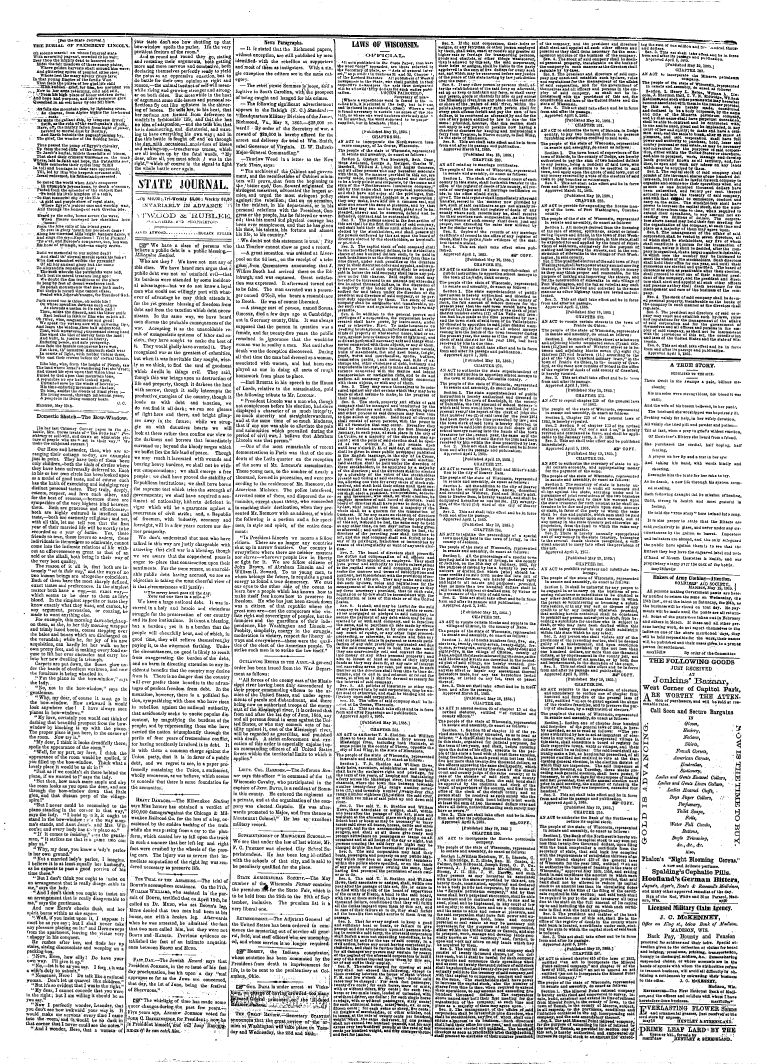
-
Description
On May 19th, 1865 the Madison Wisconsin State Journal wrote an article “The Burial of President Lincoln”. Half way down the article, the writer starts to shift topics towards the widow Mary Todd Lincoln. The author discusses the reaction of the local postal service do to the numerous amounts of letters addressed to Mary Todd. The company uses words like “chaotic” and “understandable.” This shows that many families in the Madison area wanted to show their respect towards the Lincoln family. Unfortunately the author did not discuss the reaction of Mary Todd on this topic but the article assumes that she was grateful. -Andre Doucette
-
Source
Newspaper Archive
-
Rights
This item is in the public domain and may be reproduced and used for any purpose, including research, teaching, private study, publication, broadcast or commercial use, with proper citation and attribution.
-
Creator
Madison (Wisconsin) State Journal
-
Date
May 19, 1865
from May. 10, 1865
Trail of the Murderers
-
Full Title
Trail of the Murderers
-
Description
This newspaper article from May 10, 1865, contains reactions from Racine, Wisconsin's point of view. This article contains excerpts about the escape route of John Wilkes Booth, and the plans he had, as well as the actions that he took on his journey. It also contains, a account from both Mrs. Lincoln, and Vice President Andrew Johnson. In these two excerpts both Johnson and Mrs. Lincoln explain there reactions. Johnson's reaction was placing a proclamation in action that gave a reward to those who captured the killers. Mrs. Lincoln reacted through shock as she fought through the mourning of her husbands death. Finally, there is an excerpt about the funeral ceremony that explains how long and widely attended Lincoln's procession was.
-
Rights
This item is in the public domain and may be reproduced and used for any purpose, including research, teaching, private study, publication, broadcast or commercial use, with proper citation and attribution.
-
Tags
-
Cite this Item
Racine Journal. "Trail of the Murderers". Racine Journal. Remembering Lincoln. Web. Accessed May 15, 2025. https://rememberinglincoln.fords.org/node/925
from May. 10, 1865
Trail of the Murderers
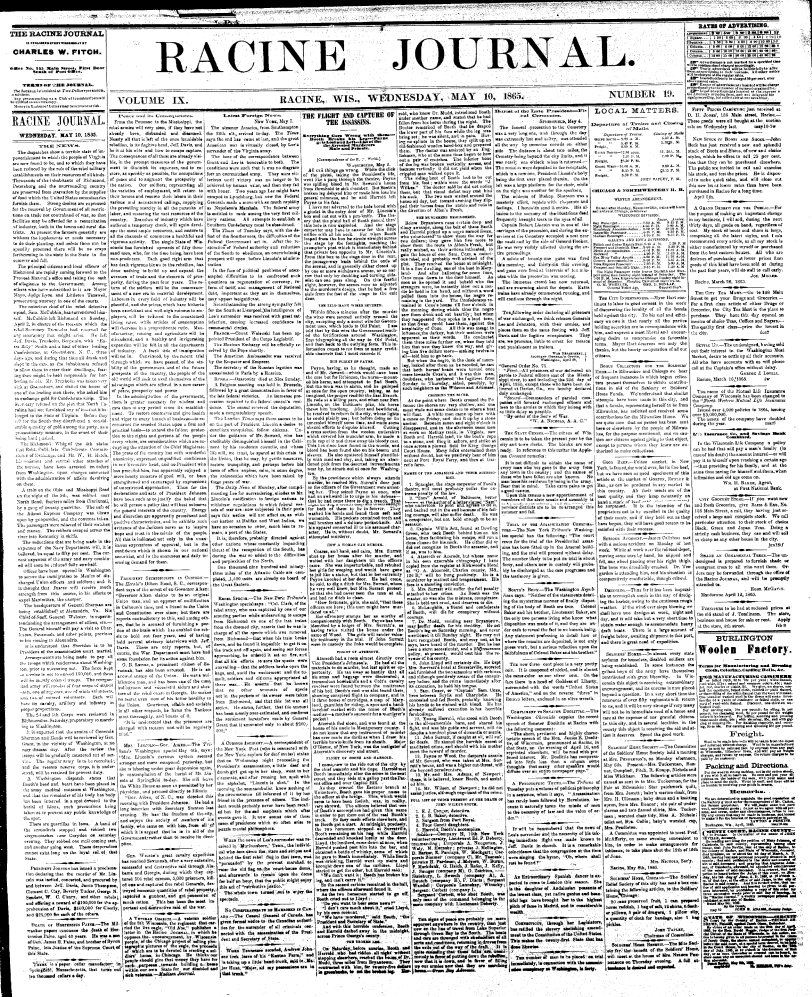
-
Description
This newspaper article from May 10, 1865, contains reactions from Racine, Wisconsin's point of view. This article contains excerpts about the escape route of John Wilkes Booth, and the plans he had, as well as the actions that he took on his journey. It also contains, a account from both Mrs. Lincoln, and Vice President Andrew Johnson. In these two excerpts both Johnson and Mrs. Lincoln explain there reactions. Johnson's reaction was placing a proclamation in action that gave a reward to those who captured the killers. Mrs. Lincoln reacted through shock as she fought through the mourning of her husbands death. Finally, there is an excerpt about the funeral ceremony that explains how long and widely attended Lincoln's procession was.
-
Rights
This item is in the public domain and may be reproduced and used for any purpose, including research, teaching, private study, publication, broadcast or commercial use, with proper citation and attribution.
-
Creator
Racine Journal
-
Publisher
Racine Journal
-
Date
May 10, 1865
from Nov. 16, 2015
Carriage Tassel and Reins
-
Full Title
LaRue Funeral Carriage Tassel and Reins
-
Description
These reins were worn by the horses that pulled President Lincoln's funeral car through Philadelphia during the funeral procession in April 1865. The train carrying the President's body arrived in Philadelphia on April 22 and the body was open to for public viewing in Independence Hall on April 23. The reins were owned by Albert LaRue, who drove the horses pulling the Lincoln's casket throughout the city.
-
Source
The Abraham Lincoln Foundation of The Union League of Philadelphia (Object ID: 1979.35.1A-D)
-
Rights
Use of this item for research, teaching and private study is permitted with proper citation and attribution, as “Courtesy of The Abraham Lincoln Foundation of The Union League of Philadelphia.” Reproduction of this item for publication, broadcast or commercial use requires written permission. For permission, please contact The Abraham Lincoln Foundation.
-
Tags
-
Cite this Item
Unknown. "LaRue Funeral Carriage Tassel and Reins". Remembering Lincoln. Web. Accessed May 15, 2025. https://rememberinglincoln.fords.org/node/916
from Nov. 16, 2015
LaRue Funeral Carriage Tassel and Reins
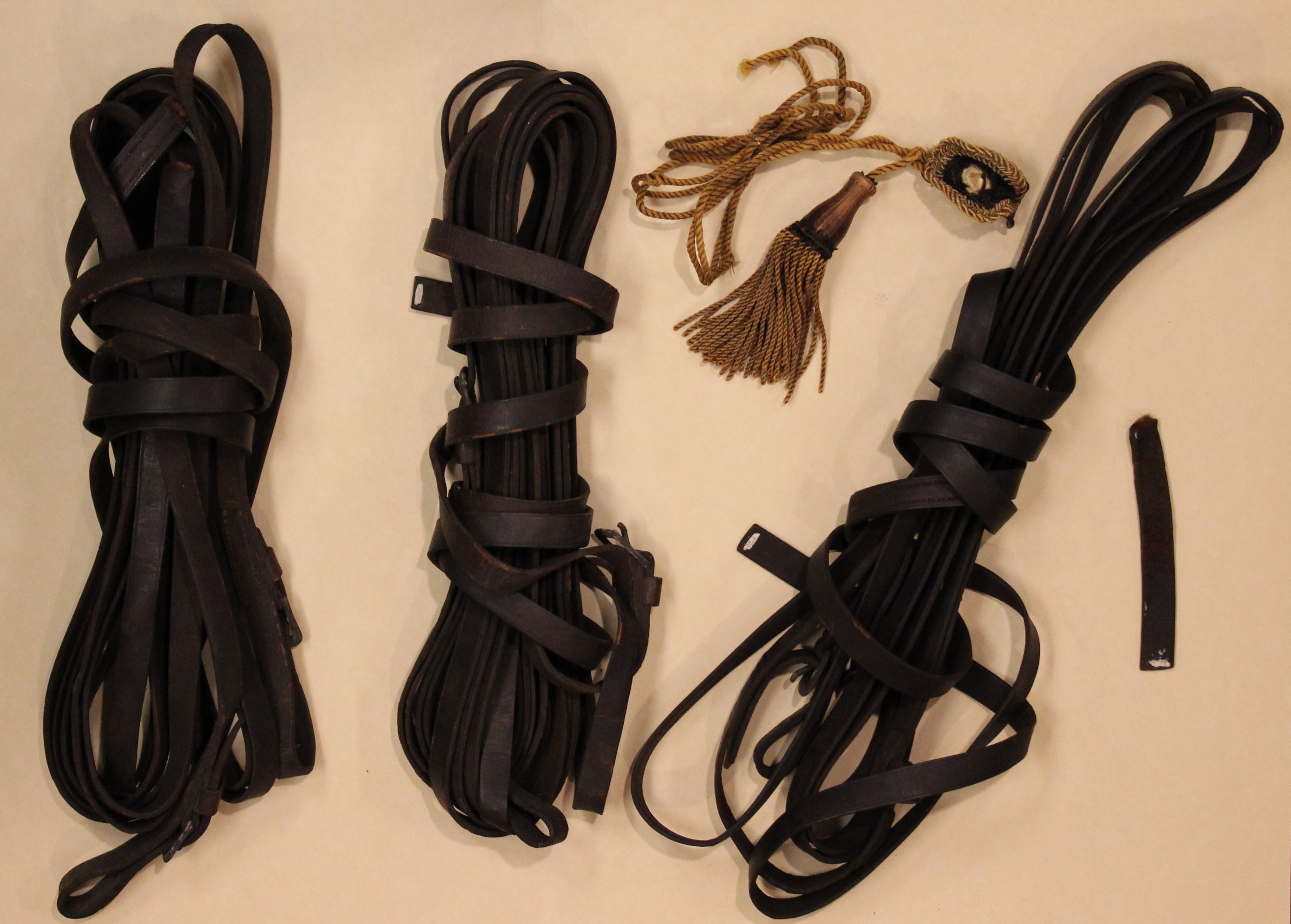
-
Description
These reins were worn by the horses that pulled President Lincoln's funeral car through Philadelphia during the funeral procession in April 1865. The train carrying the President's body arrived in Philadelphia on April 22 and the body was open to for public viewing in Independence Hall on April 23. The reins were owned by Albert LaRue, who drove the horses pulling the Lincoln's casket throughout the city.
-
Source
The Abraham Lincoln Foundation of The Union League of Philadelphia (Object ID: 1979.35.1A-D)
-
Rights
Use of this item for research, teaching and private study is permitted with proper citation and attribution, as “Courtesy of The Abraham Lincoln Foundation of The Union League of Philadelphia.” Reproduction of this item for publication, broadcast or commercial use requires written permission. For permission, please contact The Abraham Lincoln Foundation.
-
Creator
Unknown
-
Date
November 16, 2015
-
Material
Leather, metal, silk
-
Dimensions
The reins were not uncoiled for measurement. The tassel measures nine inches long.
